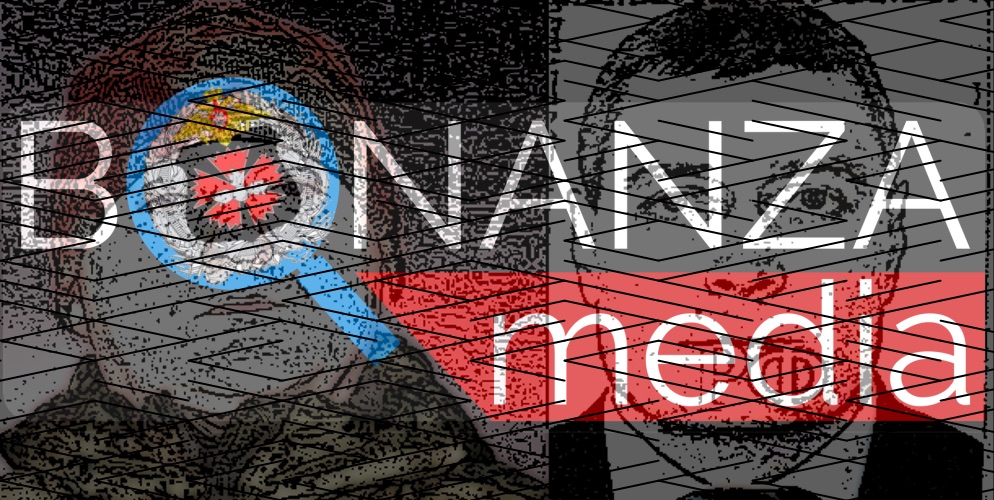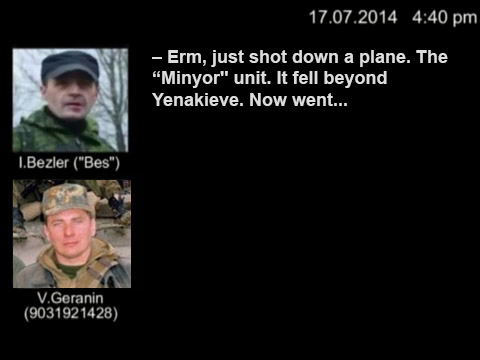JIT Indictments and Reactions: Analyzing New Evidence Linking Separatists and Russian Officials to MH17
Today, 17 July 2019, is exactly five years since Malaysian Airlines Flight 17 (MH17) was shot down by a Buk missile, fired from territory in East Ukraine controlled by Russian-directed militants. After five years it has become clear that the Buk missile launcher that downed the plane came from Russia’s 53rd Anti-Aircraft Missile Brigade, and that separatist officers and Russian officials are suspects in the tragedy that killed all 298 people on board.
Listen to Bellingcat’s new podcast on the MH17 investigation.
On 19 June 2019, several hours after the Bellingcat Investigation Team published the 88-page report A Birdie is Flying Towards You: Identifying the Separatists Linked to the Downing of MH17, the international Joint Investigation Team (JIT) announced that international arrest warrants were issued against four separatist commanders of the so-called Donetsk People’s Republic (DNR) for alleged involvement in the shooting down of the passenger plane over Ukraine on 17 July 2014. These warrants concern Ukrainian citizen Leonid Kharchenko, and Russian citizens Sergey Dubinsky, Oleg Pulatov, and Igor Girkin — all four of whom we had also linked, among others, to the downing of MH17. The announcement by the JIT was followed by another appeal to witnesses.
The results presented by the JIT have largely confirmed some of our main findings: the DNR’s military intelligence agency — the GRU DNR — led by Dubinsky was chiefly responsible for the procurement of the Buk missile launcher in separatist-held territory that was used to shoot down MH17; the GRU DNR was also responsible for guarding the Buk at the launch site south of Snizhne around the time when the missile attack occurred; and a key role in this effort was played by Kharchenko. Additionally, the JIT presentation and the official indictment document prepared by the Security Service of Ukraine (SBU) also reveal new details about the events that led to and followed the murder of 298 civilians. In addition, some of the people whom we had identified on the intercepts have issued responses of denial, which will also be discussed here.
Leonid “Krot” Kharchenko and the shootdown of MH17
In our report we had identified Leonid “Krot” Kharchenko as the commander of a reconnaissance battalion of the GRU DNR who can be heard on two intercepted conversations with other members of the GRU DNR from 17 July 2014: one recorded at 1:09pm in which he is heard guiding platoon commander Oleg “Zmey” Sharpov to the launch site, and another recorded at 9:32pm in which he instructs company commander Eduard “Ryazan” Gilazov to bring a member of the Buk crew who lost his crew to Snizhne. The second recording was replayed during the JIT presentation with a confirmation that it was indeed Kharchenko. The JIT documents also confirmed our suspicion that Kharchenko is the person who the SBU initially dubbed “DNR terrorist” on an intercepted recording from 9:54am that same day. In this conversation, he is instructed by Dubinsky to escort you-know-what — i.e. the Buk missile launcher — from Donetsk to eventual launch site south of Snizhne, and to continue guarding it after its arrival.
In the indictments, the JIT also refers to an unpublished recording from 4:48pm on 17 July 2014, 28 minutes after the downing of MH17, in which Kharchenko reports to his superior Dubinsky that “they are at the spot and have already downed one Sushka”. This suggests that Kharchenko’s unit was still with the Buk and its operators during the fatal launch, and that he initially believed that they shot down a Ukrainian Sukhoi (“Sushka”) military aircraft rather than a passenger plane.
Whether Kharchenko is still active in the separatist movement today is unknown, but the JIT announced that they assume he is still in eastern Ukraine. Recently, SBU representative Igor Guskov also refuted rumors of Kharchenko’s death and stated that they have information that points to the contrary. Guskov also provided new details of Kharchenko’s criminal past, stating that Kharchenko had already been detained in Soviet Ukraine in December 1987 at the age of 15 for participating in a gang rape. He was subsequently sentenced to five years imprisonment, and released earlier on 24 May 1991. In our report we had already collected several sources claiming that Kharchenko was involved in organized crime and had no previous military experience. Even his former commander Pulatov referred to him as a “huckster” in a forum post from 28 September 2015. Since the JIT similarly described Kharchenko as someone who had no military background, it now seems even more plausible that he had been recruited by Dubinsky in his hometown of Kostyantynivka in the early stage of the conflict due to connections in the criminal underworld.
No public reactions from Kharchenko following the indictments have been observed.
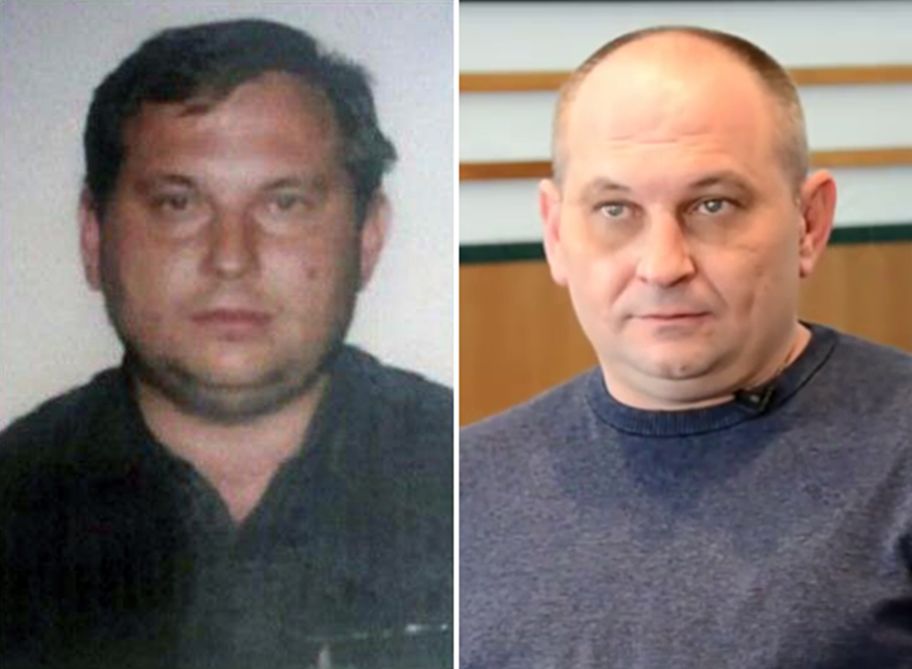
Left: An old photograph of Leonid Kharchenko. Right: Kharchenko during a video interview from early 2015.
Sergey “Khmury” Dubinsky, chief coordinator of the Buk transport in separatist-held territory
The transcript of the unpublished intercepted conversation between Kharchenko and his commander Sergey “Khmury” Dubinsky also suggests that Dubinsky himself was not near the missile launcher at the time of the launch. This corresponds with an intercepted conversation between Dubinsky and Sergey “Botsman” Povalyaev recorded sometime after the downing in which Dubinsky states that they are in Marynivka — a frontline village 10 kilometers southeast of the launch site — and that they had just struck a “Sushka”. The exact time of this conversation has not been shared with the public, but since Dubinsky still seemed uninformed about the downing of the passenger aircraft, the conversation most likely took place shortly after he was informed by Kharchenko at 4:48pm that the Buk was used to shoot down a Sushka.
Immediately after the indictments were announced, Sergey Dubinsky refuted the allegations made against him in a conversation with The Guardian correspondent Andrew Roth, stating “I don’t believe in the objectivity of this investigation”. He also neither confirmed nor denied that it was his voice heard on the intercepted conversations, answering: “Let them say what they will”. However, Novaya Gazeta published a forensic comparison between the voices of “Khmury” and Sergey Dubinky, that showed a positive match. Furthermore, in a forum post from 2 August 2015 Dubinsky admitted that at least one of the recordings was authentic and in the only known video of “Khmury” the voice sounds very similar to the voice of Dubinsky. Although Dubinsky is wearing a ski mask in this recording, he has previously admitted that it is him. This is also apparent when comparing a wrinkle/scar visible near his left eyebrow:
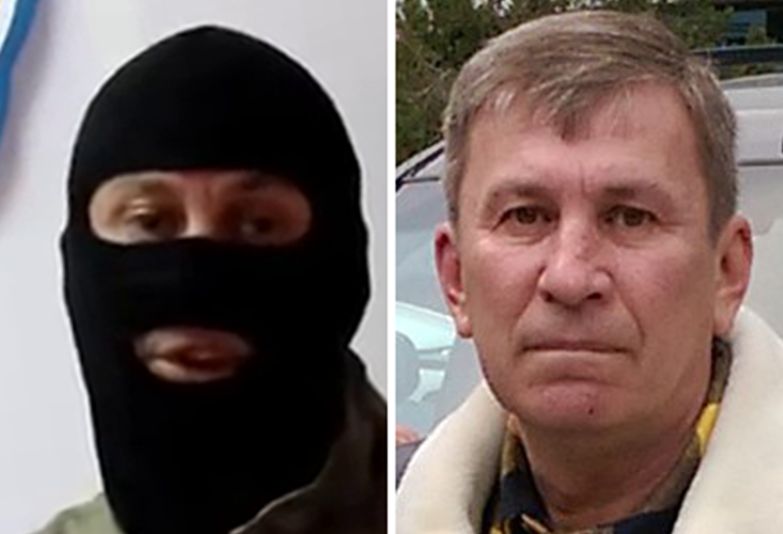
Left: A still of a masked Dubinsky from a video interview from June 2014 in Kramatorsk (during the Battle of Slovyansk). Right: A photo of Dubinsky from October 2017 during a meeting with Igor Bezler in Russia.
Dubinsky also spoke to BBC Russian Service correspondent Ilya Barabanov. In his defense he claimed that when the downing occurred, he was not in any of the areas east of Donetsk — a region that includes the launch site south of Snizhne as well as the village of Marynivka — and suggested that Ukrainian telecom data would prove him right. However, this appears to be a rebuttal to a fact that has not been claimed by the JIT or in the SBU’s indictments. In the original uploads by the SBU it is only stated that Dubinsky was in Donetsk when he was informed at 9:08am that the Buk and its crew had arrived there. It is possible that Dubinsky remained at his headquarters in Donetsk after he ordered his subordinates to escort the Buk from Donetsk to the eventual launch site south of Snizhne. If he was still there when the downing occurred, this would mean that shortly after the downing Dubinsky was only bragging when he told “Botsman” that he was stationed in the frontline village of Marynivka. The JIT undoubtedly has the answer to this question since they obtained all relevant telecom data from Ukraine, and previously already determined which telephone cell-towers received signals during the phone calls.
Nevertheless, even in the case Dubinsky was far removed from the launch site when the shootdown occurred, this would in no way exempt him of involvement in the downing of MH17. The intercepted conversations indicate that he had himself requested to receive the Buk missile launcher and had instructed his men to deploy it south of Snizhne on the day of the shootdown. As the organizing force behind a secretive plan to shoot down Ukrainian military aircraft using a high-altitude surface-to-air missile launcher in an area where civilian airliners which still regularly flying, Dubinsky also shared a responsibility to make sure that civilians would not be targeted.
Another argument used by Dubinsky in his attempt to counter the accusations in JIT’s indictment was that in his role as head of GRU-DNR, i.e. in an intelligence role, he could not have had a mandate to procure weapons from Russia. Again, this appears to deflect from the actual charges in the indictment, which engage his responsibility in securing the transport of the fatal weapon and in hiding the evidence following the crime.
Oleg “Gyurza” Pulatov and the securing of the launch site
Another unpublished recording mentioned in the indictments concerns a message from 9:55am on 17 July 2014 in which Dubinsky instructs Oleg “Gyurza” Pulatov to receive the Buk from Kharchenko, to go to the area near Pervomayskyy (south of Snizhne), and to guard the missile launcher there together with Kharchenko and other members of the military unit. This matches the known intercept between Dubinsky and Kharchenko recorded one minute earlier, in which Dubinsky tells Kharchenko that “Gyurza” will also join him after he has brought the Buk to the area south of Snizhne.
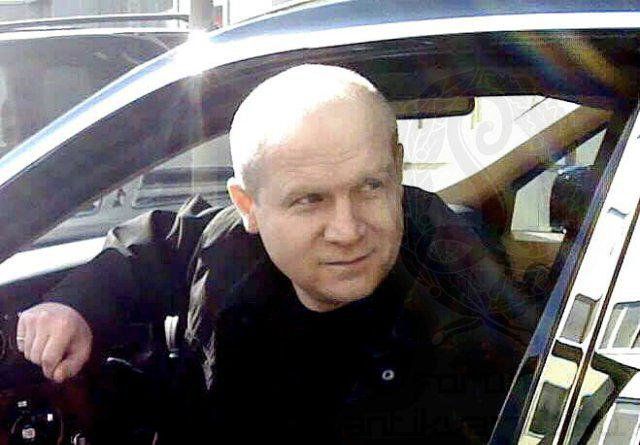
A photograph of Oleg “Gyurza” Pulatov, uploaded in 2015 to a Russian forum.
We had determined that Pulatov was at the time the commander of the GRU DNR’s 2nd Department which consisted of reconnaissance and special forces units (including the reconnaissance battalion commanded by Kharchenko). Pulatov previously denied that the GRU DNR was involved in the downing of the aircraft, though he admitted in a forum post from 25 April 2017 that he was generally stationed south of Snizhne around that time and that they had a Strela-10 medium-range surface-to-air missile launcher. In the same post he also claimed he had traveled towards the crash site near Hrabove shortly after MH17 had crashed.
The JIT indictments now mentions that Pulatov was already ordered by Dubinsky on 6 July 2014 to conduct an on-site reconnaissance at the frontline near the village of Dmytrivka to the south of Snizhne because they had received an assignment to break a corridor to the Russian Federation. The capture of this border area became their most important strategic objective — apart from creating a second supply line for the separatists, it would also create a pocket with thousands of Ukrainian forces who were stationed to the east along the border with Russia at the time.
The offensive to capture this border area began ten days later on 16 July with the capture of the village of Marynivka by the separatists. Units of the GRU DNR had also participated in this assault. In our report we identified Pulatov in a video from 16 July in which he is seen together with the self-declared Minister of Defense of the DNR, Igor Girkin, and the self-declared Prime Minister of the DNR, Aleksandr Borodai. In the video, Girkin gives an update about the capture of Marynivka, and can also be seen ordering Pulatov to take out a mortar battery. The video was recorded in a field south of Snizhne that was just 10 kilometers removed from the eventual launch site, and it also shows that they had a Strela-10 missile launcher with them.
Shortly after the indictments were announced, Pulatov also issued a statement of denial of separatist involvement in the downing of MH17. He did so in a message to the JIT with a tirade calling them shameful and sellouts to U.S. interests. This was a response to a VK direct message from JIT informing Pulatov shortly in advance of the press conference announcing the charges against the four suspects, that he was going to be indicted. Pulatov posted a screenshot of this exchange on an anonymous Odnoklassniki profile having the name “Svyatoy Stalin” (Saint Stalin) that we previously identified as belonging to him. The screenshot reveals that he had browser tabs open for our website (and that of Novaya Gazeta) when he sent them the message:
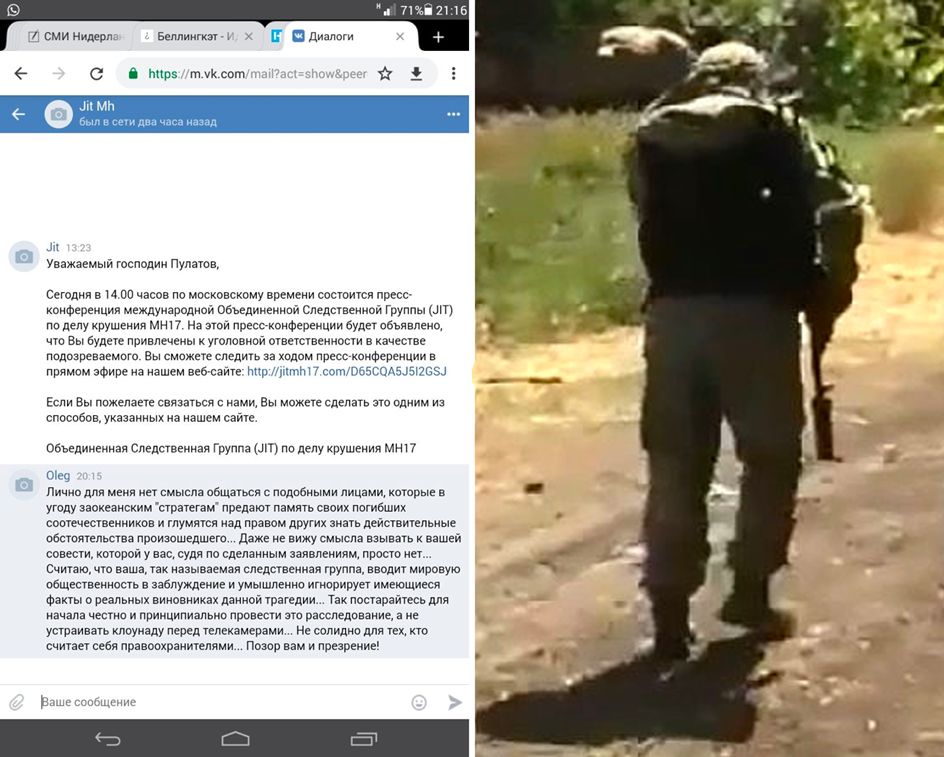
Left: The response to the JIT issued by Pulatov via VK. Right: Pulatov’s profile photo on his anonymous Odnoklassniki profile taken from the 16 July 2014 video with Strelkov, Borodai, and a Strela-10 missile launcher. Pulatov had added this photo on 18 July 2014, just one day after the downing of MH17.
Igor Girkin and alleged Kremlin involvement
The decision of the JIT to also accuse Igor Girkin (a.k.a. Igor Strelkov) of involvement in the downing of MH17 was predictable since he was the DNR’s Minster of Defense at the time. In our report we identified Girkin in one of the intercepts from 18 July 2014 that indicated he was involved in the removal of the Buk and its crew back to Russia. While we previously explained that Girkin must have had knowledge about the arrival of the Buk missile launcher on 17 July 2014 because he was the military leader of the DNR and a close ally of his subordinate Dubinsky, we had not yet seen any evidence that he personally participated in arranging the actual delivery or deployment. However, the JIT has presented more evidence that suggests Girkin was involved in both the procurement and deployment of the Buk missile launcher and that he had coordinated this with senior Russian officials.
The JIT first replayed two intercepted recordings of Girkin: one conversation with Sergey Aksyonov, at the time the Russian-installed Prime Minister of the recently annexed Crimea; and another with Aksyonov’s assistant, Mikhail, both dated 8 June 2014. In them, Girkin can be heard requesting extensive Russian assistance in the form of tanks, anti-artillery, and air-defense systems with trained crews in order to hold out during the Battle of Slovyansk — the first major confrontation between the Russian-backed separatists and the Ukrainian Armed Forces in the Donbas region.
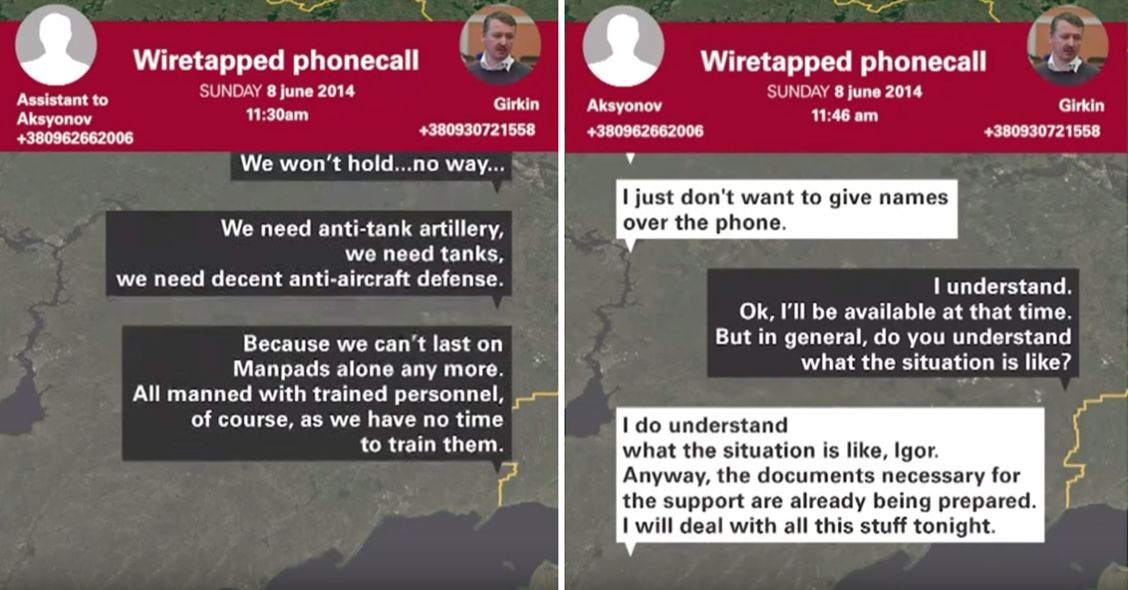
Parts of the conversations between Strelkov and Aksyonov plus Aksyonov’s assistant as shown by the JIT.
Girkin can easily be recognized on the recording, and the same goes for Aksyonov who has a very distinctive manner of talking. The identity of Aksyonov’s assistant has not been revealed, but this most likely concerned Mikhail Sheremet, the former head of the pro-Russian “self-defense” militia of Crimea and a close ally of Aksyonov. At the time, he was the Russian-appointed First Deputy Chairman of the Council of Ministers of the Republic of Crimea. Recordings of Sheremet reveal that his voice sounds very similar to the Mikhail we hear in the intercepted conversation with Girkin.
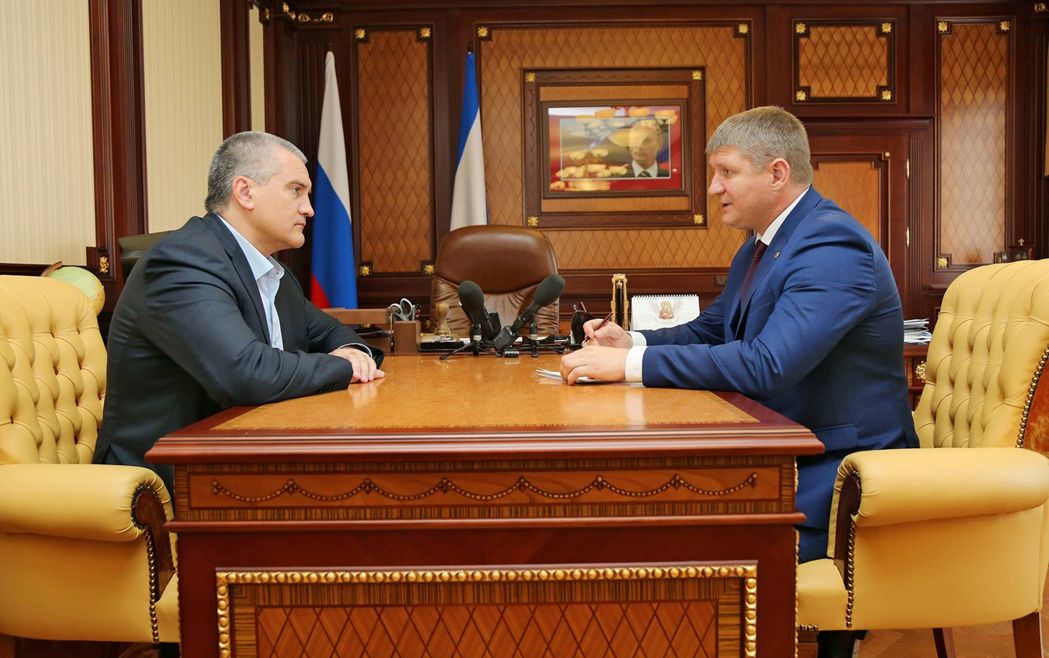
Sergey Aksyonov (left) and Mikhail Sheremet during an official meeting in Russian-annexed Crimea on 7 June 2016
In a response on his VK page, Girkin once again denied that the separatists had anything to do with the downing of MH17 and added that he will not answer any questions related to the case. This appears to be the same stance as Dubinsky, who wrote on 24 July 2015 that he does not answer questions related to the downing of the plane. Since both men have no problem with discussing all their other military adventures in the summer of 2014, their silence on MH17 may have been part of a coordinated strategy. Nevertheless, Girkin did comment on the recording with Aksyonov: he neither confirmed nor denied that the recording was real, but pointed out that a request for military assistance does not prove that he actually received such weapons from Russia.
However, on 23 June 2014, about two weeks after the call between Aksyonov and Girkin, a military convoy left the 53rd Anti-Aircraft Missile Brigade of the Russian Armed Forces and moved towards the border with Ukraine, as we already revealed in November 2014. In the indictments it is noted that the “military exercise” was in pursuant of orders already signed on 19 and 21 June 2014. Although announced as an army exercise, the convoy included six Buk missile launchers, one of which was Buk 332 (formerly known as Buk 3×2) — the weapon that crossed the border with Ukraine in the night of 17 July 2014 and was used to shoot down MH17 that same day. The intercepted conversations have indicated that the Buk crew also came from Russia, just as Girkin had asked for.
The JIT stated that Girkin asked for military support on more occasions in telephone calls with people based in Russia throughout June and July 2014. The same goes for Aleksandr Borodai, at the time the self-declared Prime Minister of the DNR and close associate of Girkin, who also regularly visited Moscow during this period. The JIT also pointed to a press conference from 10 July 2014 held by Girkin and Borodai in which the latter was asked whom he had met during a recent trip to Moscow, and answered:
“I was there for political consultations, which, in my opinion, went fairly successful. With respect to the people I met, I will certainly not reveal that. This secret, if you will, belongs to the area of military intelligence. However, I consider these consultations to be very successful, and I am very much counting on the assistance of the Russian Federation in the nearest possible future.”
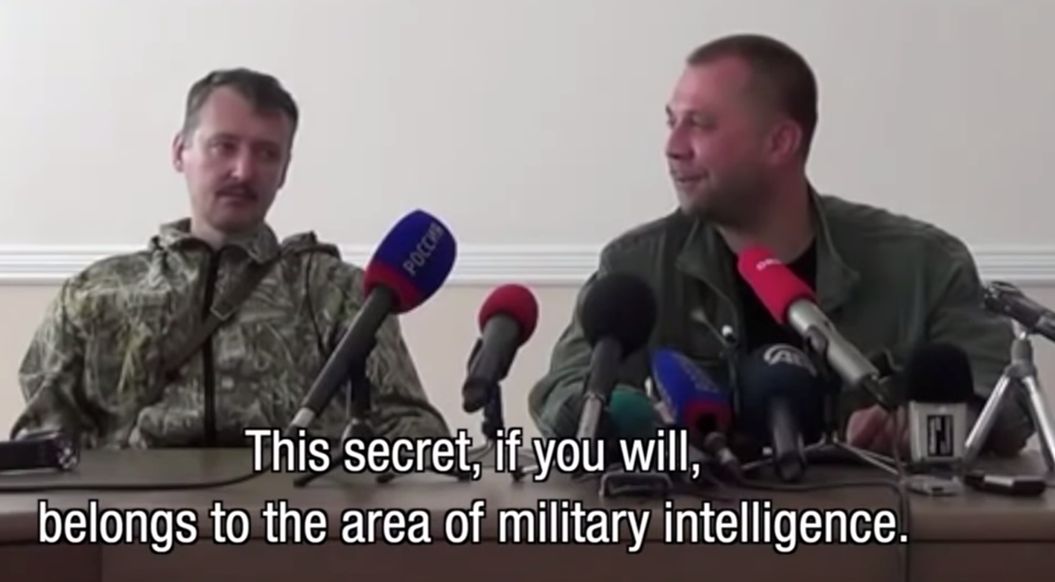
A screenshot from a video of the 10 July 2014 press conference by Girkin and Borodai
Furthermore, a new intercepted conversation made public by the JIT reveals that one day after his press conference, Borodai called with Vladislav Surkov, an adviser to Russian president Vladimir Putin and a Russian representative to the Minsk ceasefire agreements. In this intercepted conversation, it seems clear that the two were discussing forthcoming military aid to the separatists that was significantly large enough to “turn the tide”. The latter can be interpreted as a reference to the recent loss by the separatists of a large amount of territory during the Battle of Slovyansk, which had concluded just one week prior. The full transcript is as follows:
Surkov: Hello.
Borodai: Yes, Vladislav Yurevich, go ahead.
Surkov: Hello.
Borodai: Hello, hello, hello? Go ahead.
Surkov: Oh hello, it’s me.
Borodai: Yes, I knew you.
Surkov: So, I had a conversation with fellows back home, well, you know, the ones who are in charge of this whole military story.
Borodai: Uh-huh?
Surkov: And they said: “Yes, we’re up to speed on everything don’t worry, we’re aware” but steps that will turn the tide… I have already spoken much about it back there: “…we understand, we’re preparing…” But honestly, Sasha, I can’t really vouch that those answers can be relied upon. Because although I know all of them very well, there’s no… to trust them to whether or not they’re preparing something.
Borodai: Yes, I completely understand that. We’ve managed to hold out for a week already – it’s hard, but we can hold out some more.
Surkov: Well, yes Sasha, that’s about what you’ll have to try to do.
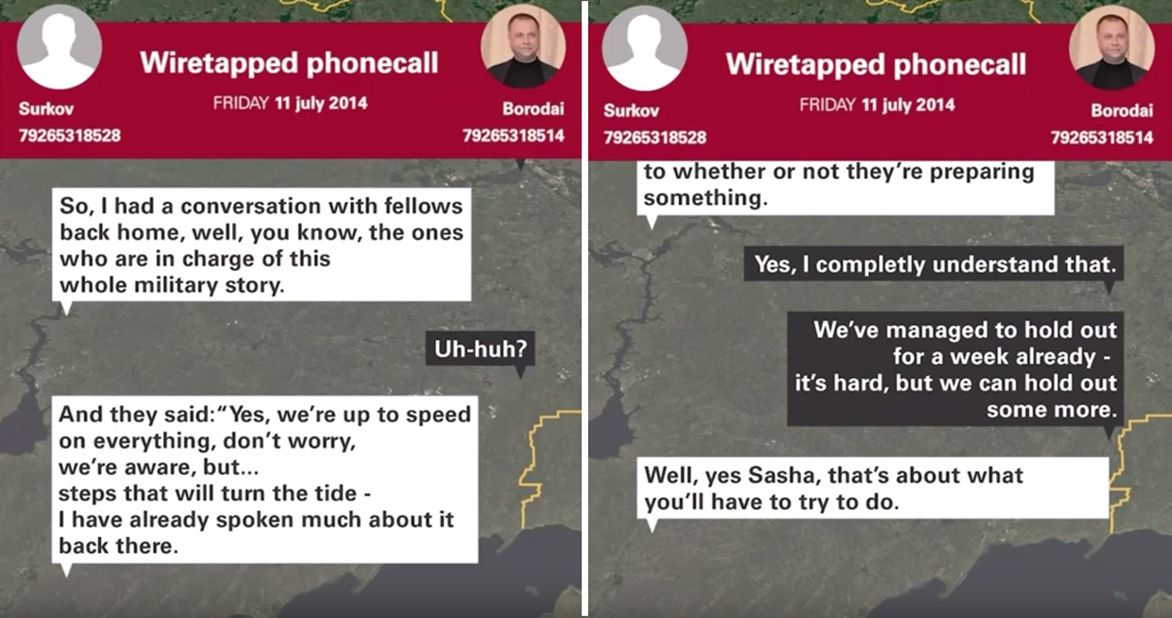
Parts of the conversation between Borodai and Surkov, as shown by the JIT.
The evidence on Surkov’s involvement in coordinating Russian military aid to the separatists is not surprising (although the fact that JIT has obtained intercepts of calls with such a high-level Russian official is new.) In an interview from 16 June 2014, Borodai had already stated: “I also know and respect for a long time the assistant to the president, Vladislav Surkov, who always provides the Donetsk People’s Republic with serious support. Without exaggeration, Surkov is our man in the Kremlin.”
Further evidence of Surkov’s coordinating role concerning Russian involvement in the War in the Donbas is contained in the so-called “Surkov leaks” — more than a gigabyte of emails and other documents from Surkov’s office that had been obtained by the Ukrainian hacker group Cyberhunta in October 2016. For example, one email sent to Surkov and others on 14 June 2014 by Denis Pushilin, the former Chair of the People’s Soviet of the DNR, contains a casualty list from 26 May to 6 June 2014 that includes the names of Russian paratroopers from the city of Pskov. The Pskov-based 76th airborne division was awarded the Order of Suvorov by Putin for unspecified tasks in August 2014 (this is not surprising, as we had previously proven that thousands of Russian servicemen participated in combat operations in eastern Ukraine in 2014 and 2015 and were awarded medals for their actions). Other leaked material, published by InformNapalm, also detail how Surkov coordinated affairs with major separatist leaders, showing photos of Surkov meeting dozens of (former) separatist leaders, including Borodai and Sergey Dubinsky, during a conference in Moscow that took place on 4 November 2016.
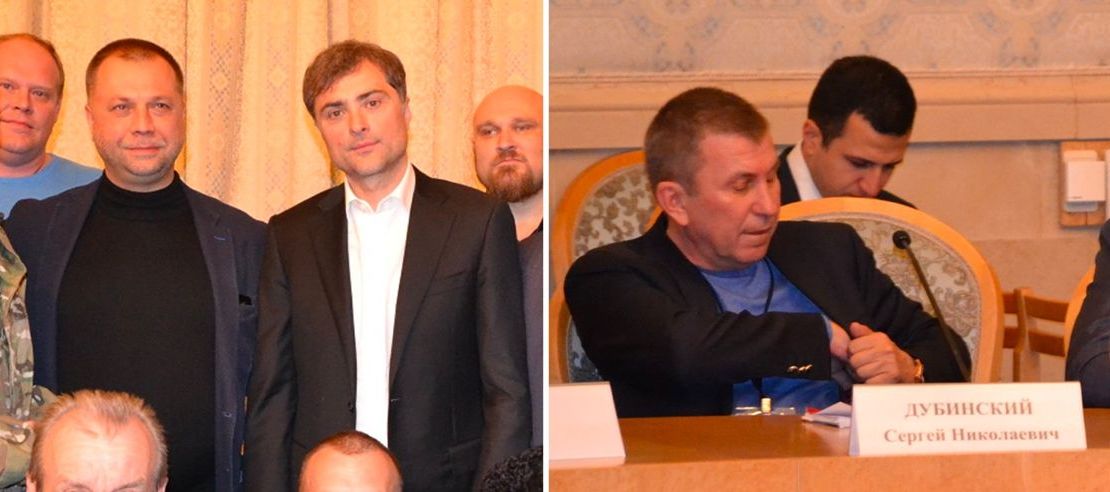
Left: Cropped version of a photo from the 4 November 2016 meeting in Moscow showing Surkov meeting with Borodai and many other (former) separatist leaders. Right: Dubinsky during the same meeting.
In the indictments it is stated that on 14 July 2014, several days after the call between Borodai and Surkov, a meeting was held in the town of Krasnodon (now Sorokine), Luhansk Oblast, close to the border with Russia, with the participation of Girkin and other separatist commanders of the DNR and the LNR, concerning their coming under command of a newly-created headquarters in Krasnodon. During the meeting, agreements were made on the coordination of military operations by the DNR and LNR militias as well as the centralized provision of military equipment to them from the Russian Federation, which was to be arranged by this newly-established Krasnodon headquarters under the command of a person with the call sign “Delfin” and his deputies who used the call signs “Dunai” a.k.a. “Orion” and “Elbrus”.
If the JIT has more objective evidence that this meeting took place then it would add to the already substantial evidence that by the summer of 2014, the bulk of the ostensibly independent separatist movement was under the direct command of the Russian Armed Forces and the Russia’s intelligence services. After the JIT had published a call to witness regarding the identities of “Delfin” and “Orion”, we identified Delfin with a high degree of certainty as (retired) Russian colonel-general Nikolay Tkachev and “Orion” as active Russian GRU officer Oleg Ivannikov. When Girkin was asked about Delfin in an interview from 5 November 2014 with controversial Swedish-Russian commentator Israel Shamir, he answered:
“I met him in Krasnodon a month before my departure. He, of course, is a good military specialist, but all of his military experience is in commanding regular troops, where there’s discipline, unconditional submission. And here, there is partisan warfare, scattered units. He did all that he could, but he was not able to take full command. He was only able to coordinate between separate units.”
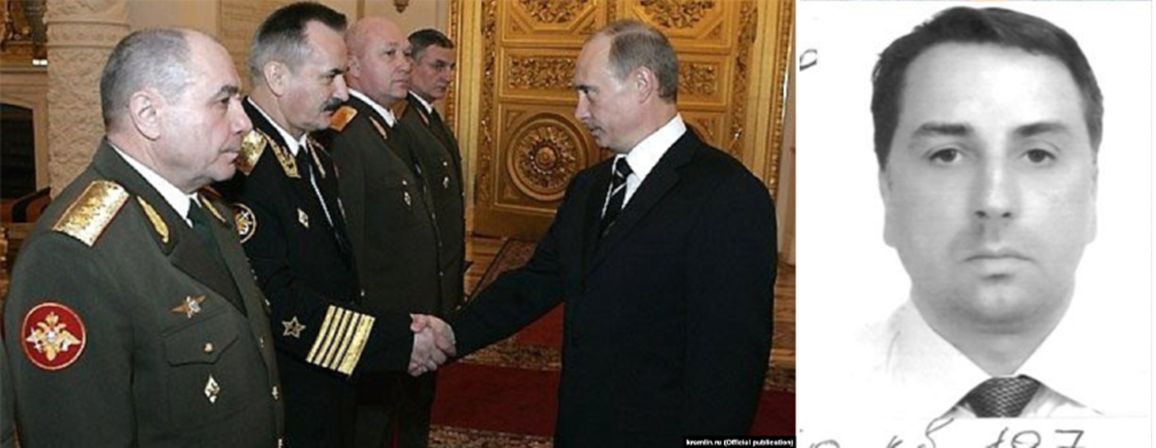
Left: A photo of Nikolay Tkachev (putatively “Delfin”, far left) and other army officials during a meeting with President Vladimir Putin inside the Kremlin in 2007. Right: A photo of GRU officer Oleg “Orion” Ivannikov.
Girkin departed from the Donbas after resigning as the DNR’s Minister of Defense, which is exactly one month after the meeting took place according to the indictment. It also matches with a description that came with the interview by the most famous pro-separatist blogger “Colonel Cassad”, who also confirmed the role of Delfin and the formation of a command center in Krasnodon:
“I can clarify that ‘Delfin’ and ‘Elbrus’ were involved in the coordination of separatist units in the LNR and partly in the DNR. One was in Krasnodon, the other in Luhansk. This coordinating headquarters started working openly after a Bezler [i.e. separatist commander Igor Bezler] visit to Moscow. As far as I know, ‘Delfin’ himself came with the rank of Kombrig ‘on vacation’.”
In the indictments it is stated that the meeting in Krasnodon resulted in the arrival of a military convoy from Russia on 15 July 2014, which was filmed by multiple people driving from Luhansk to Donetsk. This convoy was escorted by three vehicles — a gray Rav4 SUV, a camouflaged UAZ, and a dark blue Volkswagen van — that were also filmed and photograph two days later escorting the Buk convoy through DNR-controlled territory. Eyewitnesses had first spotted the 15 July convoy at 00:18 as it drove through Krasnodon from the direction of Russia. This is notable because the Buk was also believed to have been transported across the border under the cover of darkness in the night of 17 July 2014 (this was already reported by the SBU one day after the downing but is also repeated in the indictments).
It is also stated in the indictments that at 11:24am on 17 July, as the Buk was being transported from Donetsk to Snizhne, Dubinsky had a call with another DNR member in which he mentioned that he and a person with the call sign Pervyy (“The First”) — whom the SBU and JIT have identified as Girkin — “had a talk with Moscow and reached the top level” the day before. Though it is not stated what this conversation was about, it may have concerned the arrival of the Buk, which would add to the existing evidence that both Girkin and Dubinsky were involved in requesting this weapons system from Russia. In an intercepted conversation from 07:09pm on 16 July, Dubinsky can also be heard telling “Sanych” — identified by us as Aleksandr Semynov, deputy commander of the Vostok Brigade, who recently responded by casting doubt on the authenticity of the phone intercepts — that he hopes to receive a Buk missile launcher in the morning to protect his forces at the frontline south of Snizhne.
The removal of the Buk missile launcher back to Russia
The indictments also reveal new details about the removal of the Buk missile launcher from the launch site back to the Russian Federation. In the SBU documents, it is stated that at 8:30pm on the day of the MH17 downing, Girkin ordered his subordinate Dubinsky to escort the Buk together with two BTR armoured vehicles to the administrative border of the Luhansk Oblast for its subsequent evacuation to Russia (this order was given not long after sunset, with the removal of the Buk most likely planned to happen under the cover of darkness). One hour later (at 9:32 pm), the earlier mention conversation between Kharchenko and Gilazov took place, in which Gilazov was ordered to escort one of the Buk operators, who had lost his colleagues, from an unspecified checkpoint to Snizhne. The indictments mention another conversation from 10:35pm, in which Dubinsky orders his subordinate Kharchenko to transport the Buk to the border of the Luhansk Oblast and to hand it over to people who are expected to arrive there to pick it up. Immediately thereafter, Kharchenko instructed an unidentified subordinate (“Person 9” in the indictments) to perform this task.
While it has not been specified where this transfer was supposed to happen, it most likely concerned a journey from Snizhne (Donetsk Oblast) to Krasnyi Luch (Luhansk Oblast) — a town which was at the time under the control of the so-called Cossack National Guard (led by Nikolay Kozitsyn). According to the reconstruction by the JIT, the Buk drove back to Snizhne on its own power, though the JIT did not clearly specify at what time this took place. In Snizhne it was reloaded onto the Volvo low-loader and transported eastwards to the Luhansk Oblast. After arriving in Krasnyi Luch, it was transported via Debaltseve and Luhansk over the highway to the border with Russia where it arrived in the morning of 18 July 2014.
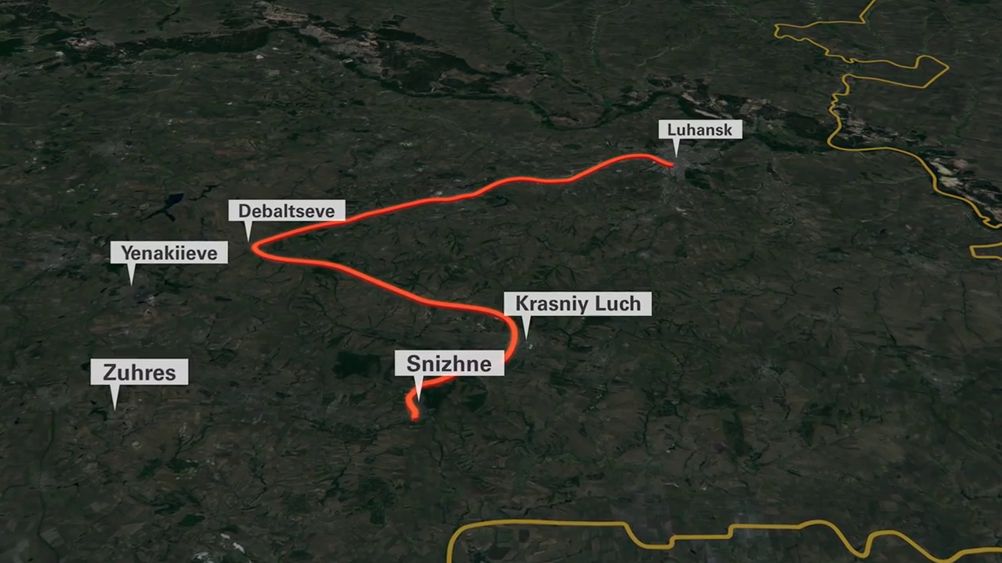
The reconstructed route on which the Buk was removed according to the JIT.
In Luhansk, the Buk had been filmed in the early morning hours with three instead of four missiles while transported on top of the low-loader, which reveals that the people escorting the missile launcher had failed to keep the removal hidden from the public eye.
Where the Buk was standing before it was transported from Snizhne to Luhansk Oblast is unknown, but in our recent publication concerning the arrest by Ukrainian security agents of Vladimir Tsemakh, a separatist air defense commander from Snizhne, we discussed what Tsemakh’s role could have been during this period. In an accidental confession, Tsemakh told an interviewer on camera: “I pulled out that young guy, and I hid this [Buk]. I will show you even where it lifted off, and where I picked it/him up”, which suggests that he was involved in hiding the Buk missile launcher and at least one of its crew members after the downing.
Intercepted conversations between Dubinsky, Kharchenko, and Girkin from the following morning reveal further details about the hectic removal of the Buk to Russia. At 7:41am or 8:01am (the given times are contradictory) on 18 July, Dubinsky is informed over the phone by Kharchenko that the Buk has arrived in Russia, much to the delight of Dubinsky who had no idea where the vehicle was since the previous night. The indictments reveal that shortly thereafter, Dubinsky called Girkin and told him that a militant with the call sign “Bibliotekar” (who was also involved in the arriving Buk transport) had successfully brought the Buk to the Russian Federation.
In the indictments it is also stated that “Delfin” and “Orion” personally supervised the entire evacuation of the Buk and issued instructions over the phone to the persons involved in its transportation. This suggests that the JIT has obtained more evidence about direct Russian state-level involvement in the entire operation.
Conclusion
The JIT and SBU indictments confirm the identity and role of key militants, as previously identified by Bellingcat, in the procurement of the Buk missile launcher from Russia, its transport to the launch site and its repatriation to Russia following the crime.
At the same time, the new documents, and in particular the long-form SBU charging documents, provide further information about the sequence of events and decision-making that led to the tragedy on July 17 2014.
The additional evidence presented during the JIT press conference also sheds new light on the decision-making that led to the Russian state making the weapon available for use in Eastern Ukraine. Crucially, the JIT disclosed evidence for the first time that high-level Russian officials, such as the Russian president’s advisor Vladislav Surkov and “Prime Minister of Crimea” Sergey Aksyonov played a role in procuring Russian weaponry for the militants in the period preceding the crime. Such evidence raises the question whether the list of indicted persons will be broadened to include government officials based on “chain of command” criminal responsibility principles. The JIT left this possibility open by stating the list of currently charged persons is not comprehensive and that other potential suspects have not been disclosed due to the secrecy of ongoing investigation.
Notably, the current indictments do not address the criminal responsibility for the actual operation of the Buk missile launcher. Given that this sophisticated weapon was procured from the 53rd Anti-Aircraft Missile Brigade of the Russian army, and preliminary evidence suggests it was provided together with a team from the same brigade, it is unlikely that the JIT will not address the criminal liability of the Buk crew in future indictments. The omission of Russian military officers or soldiers from the initial indictments may indicate either absence of conclusive evidence on the identity of the actual operating team, or pending legal qualification of the criminal act. In particular, if the crime is assessed to have taken place during a military conflict to which the Russian state was a party, the criminal liability may not lie in the operators but in the highest position of the chain of military command that permitted and/or instructed the use of the Buk. The renewed call for witnesses that the JIT published at the end of their press conference suggests that it is exactly the military chain of command that the investigation will focus on in the remaining months before the start of the court proceedings in March 2020.
